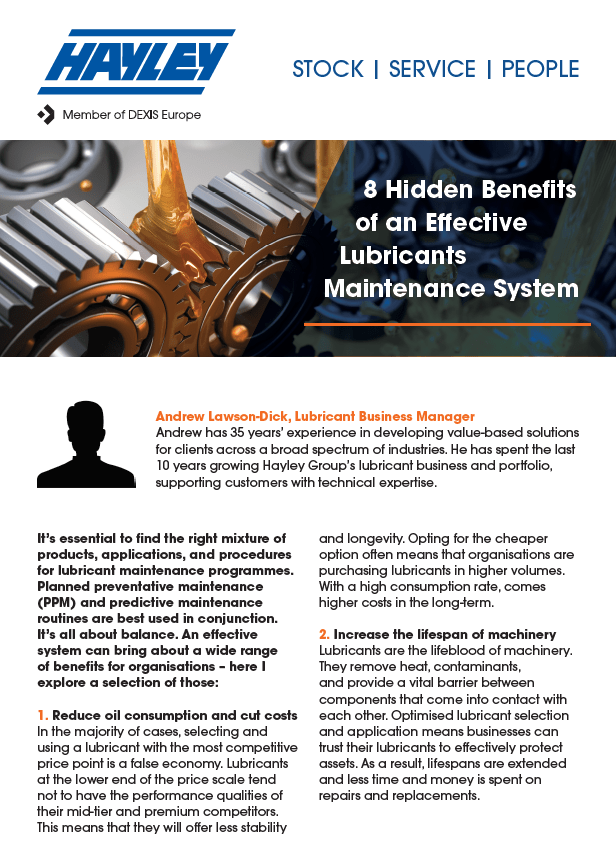by Andrew Lawson-Dick, Lubricant Business Manager
Andrew heads-up the Lubricants division at Hayley Group. He has 35 years’ experience in developing value-based solutions for clients across a broad spectrum of industries. He has spent the last 10 years growing Hayley Group’s lubricant business and portfolio,
supporting customers with technical expertise.
It’s essential to find the right mixture of products, applications, and procedures for lubricant maintenance programmes. Planned preventative maintenance (PPM) and predictive maintenance routines are best used in conjunction. It’s all about balance.
An effective system can bring about a wide range of benefits for organisations – here I explore a selection of those:
1. Reduce oil consumption and cut costs
In the majority of cases, selecting and using a lubricant with the most competitive price point is a false economy. Lubricants at the lower end of the price scale tend not to have the performance qualities of their mid-tier and premium competitors. This means that they will offer less stability and longevity. Opting for the cheaper option often means that organisations are purchasing lubricants in higher volumes. With a high consumption rate, comes higher costs in the long-term.
2. Increase the lifespan of machinery
Lubricants are the lifeblood of machinery. They remove heat, contaminants, and provide a vital barrier between components that come into contact with each other. Optimised lubricant selection and application means businesses can trust their lubricants to effectively protect assets. As a result, lifespans are extended and less time and money is spent on repairs and replacements.
3. Extend maintenance intervals and reduce downtime
Businesses can extend the interval at which a component or machine needs to be taken offline for maintenance purposes. This is made possible by optimising lubricant selection and implementing predictive maintenance procedures such as condition monitoring. Extending maintenance intervals reduces the burden on resources, and also helps to lessen the impact that downtime has upon production and revenue.
4. Improve the efficiency of operations
Many new premium lubricants have energy-saving technologies incorporated, such as offering greater thermal stability at higher temperatures. This means that machinery doesn’t have to work harder or consume more electricity to provide the same level of performance. With much innovation happening around automated lubrication, businesses have a proven way to improve operational efficiency. All while the automatic system guarantees accurate and consistent application.
5. Ensure compliance
Sourcing products from non-authorised distributors or lesser-known brands can present an element of risk when it comes to quality and safety. Non-compliance with stated levels of approvals can lead to future warranty claim complications. It’s also vital to assess which lubricants are used at every stage of the operation to determine for example, where NSF food safe compliance is required. This includes assessing new components that have been pre-lubricated before installation. Using genuine products and implementing proper procedures ensures regulatory compliance. It also reduces a range of risks like contamination and lost production.
6. Reduce the threat of breakdowns
A large amount of progress has been made in making laboratory testing more efficient through the use of sample kits and online portals. Also, services and technologies able to identify areas that are causing failures have also been improving rapidly.
Smart, wireless sensor technologies enable users to assess the lubricant performance at the click of a button. The speed to insight this provides, enables users to identify potential failures before they begin to impact the business. A real benefit of correctly implementing predictive maintenance techniques.
7. Set and maintain standards
By setting and enforcing standards on your lubrication practices, such programmes will show improved reliability of assets resulting in increased production outputs. With well-defined standards in-place, staff working with lubricants as part of the operation will be clear on what is expected of them when carrying out their duties. As a consequence, all assets are maintained to uniform practices, reducing the risk of any costly unplanned downtime. Utilising electronic PMS systems rather than traditional paper based full measurement, means that adjust and control methods can be introduced which offer full visibility on asset management and cost avoidance savings.
8. Ensure the safe storage and disposal of lubricants
It’s challenging to adhere to all the health and safety requirements around the safe storage and disposal of lubricants. Particularly so in a busy manufacturing or engineering environment. Labelling techniques and dispensing methods can go some way to help ensure that the correct lubricant gets used for its intended application. Methods like this also improve the safety of personnel handling lubricants. Having the right storage and disposal practices in place also ensures compliance with strict environmental legislation.



